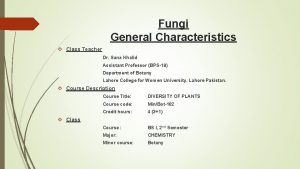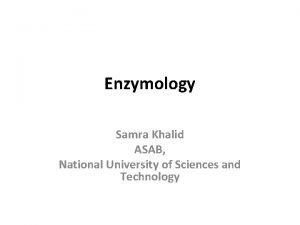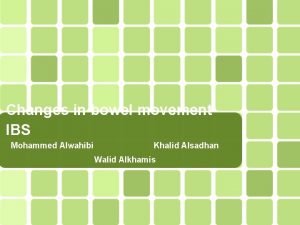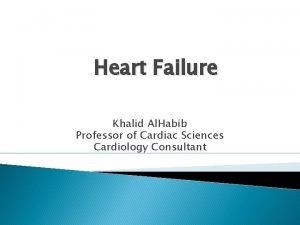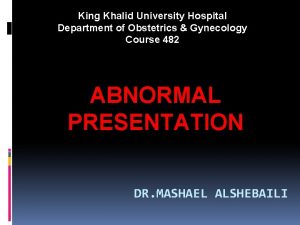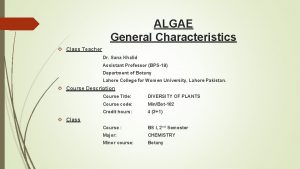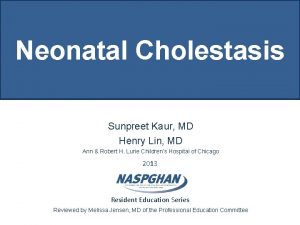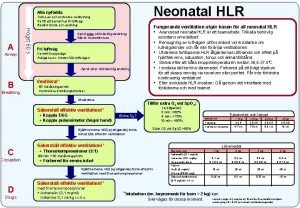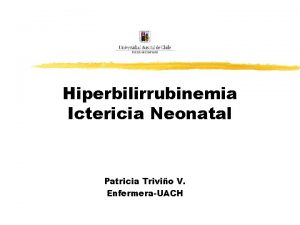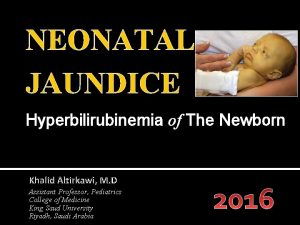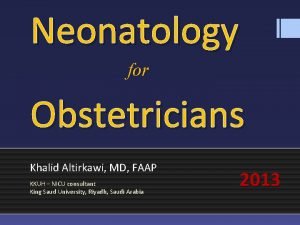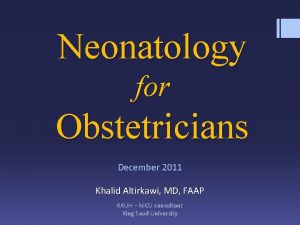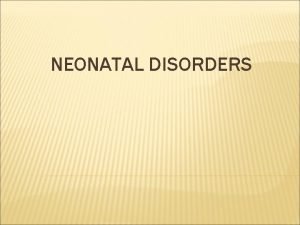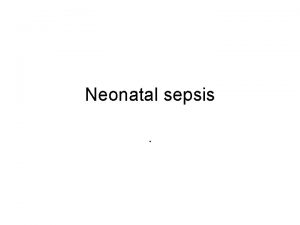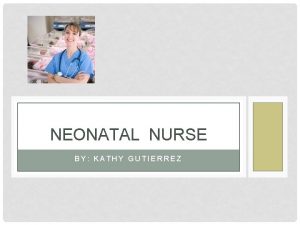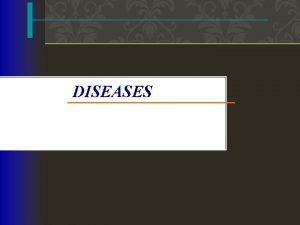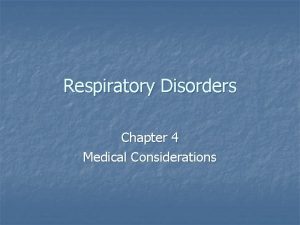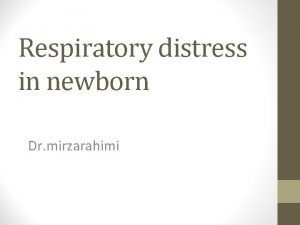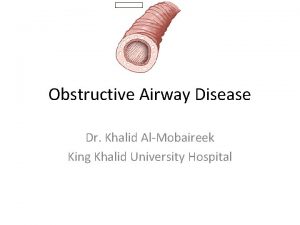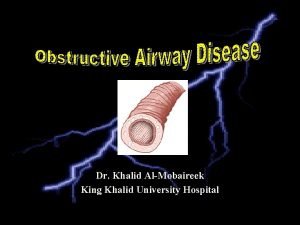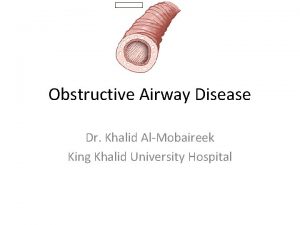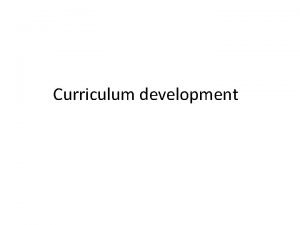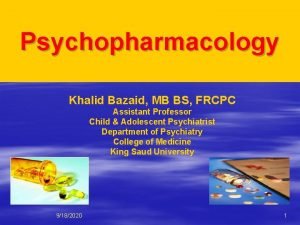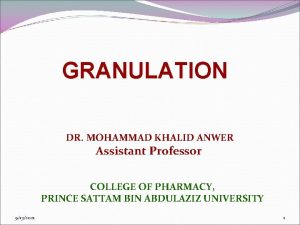NEONATAL RESPIRATORY DISORDERS Khalid Altirkawi MD Assistant Professor































- Slides: 31

NEONATAL RESPIRATORY DISORDERS Khalid Altirkawi, MD Assistant Professor, Pediatrics College of medicine King Saud University Riyadh, KSA 2016

Disclaimer This presentation is to help medical students upon the start of their rotation in Pediatrics. It is NOT to replace the recommended textbook. Khalid Altirkawi, M. D.

Objectives By the end of this presentation, the student should be able to: § Recognize the SIGNS of respiratory dysfunction in the neonate § Describe the MECHANISMS underlying the respiratory illnesses discussed § Mention the steps to DIAGNOSE and the strategies used to MANAGE these illnesses

Respiratory Signs § § § Cyanosis Tachypnea Grunting Nasal flaring Chest recessions Feeding difficulties

Central Cyanosis § Respiratory insufficiency § CNS depression § Cyanotic heart disease § PPHN § Sepsis

Peripheral Cyanosis § Local phenomenon § May take several days to resolve § No special investigations § No special therapy

Hyaline Membrane Disease (HMD) Respiratory Distress Syndrome (RDS)

RDS § Course: 3 -4 days § Prevention: antenatal corticosteroids, control of maternal diabetes § Diagnosis: § Clinical signs: Grunting, Retractions, Nasal flaring, Cyanosis § Radiographic signs: Diffuse, Ground-glass opacities, Air bronchogram, Low lung volumes (if not ventilated)

Alviolus structure

Laplace’s Law

RDS PA view of chest radiograph of an infant with RDS. Notice the following: • • • Air bronchogram (Red) Ground glass appearance e of both lungs Decreased lung expansion (Green) Endotracheal tube (Blue) Umbilical venous catheter (Yellow) Umbilical arterial catheter (Orange)

GBS pneumonia Chest radiography of infant with congenital pneumonia. Virtually indistinguishable from one of RDS patients

Transient Tachypnea of the Newborn Chest radiograph of an infant with TTNB. Notice the fluids in the fissure (Red arrows)

RDS Treatment § Exogenous intratracheal surfactant § Lowers surface tension at air-fluid interface § Improves oxygenation and increases FRC at lower airway pressures § Single treatment is enough for most newborns because type II pneumocytes recycle surfactant § Second dose may be needed in > 6 hours if surfactant inhibition occurs (e. g. in MAS)

Meconium Aspiration Syndrome (MAS)

Meconium Aspiration Syndrome Chest radiograph of an infant with MAS Notice the bilateral patchy opacities

One-way valve Mechanism

Pneumothorax • • • Aymptomatic (1 -2% of all newborn) Spontaneous vs. secondary Respiratory distress signs with/without CVS compromise Drainage of the pleural air by chest tube under water seal. Observation if no CVS compromise

Congenital Diaphragmatic Herina (CDH)

Diaphragmatic Hernia § Congenital vs. acquired § Most often left, and through the poster-lateral segment of diaphragm. § Respiratory Distress (usually severe), cyanosis, bradycardia, scaphoid abdomen § Diagnosis: signs and imaging § Management: stabilization then surgery

Diaphragmatic Hernia Right Left

Chronic lung disease (CLD) Broncho-pulmonary Dysplasia (BPD)

BPD § Lung injury due to: § Barototrauma (pressure-related) § Volutrauma (volume/expansion-related) § Oxygen toxicity § Defined by the need for oxygen therapy or respiratory support at 36 weeks post-menstrual age (PMA) § Management options ? ? ?

BPD Chest radiograph of an infant with BPD Notice the widespread haziness of both lung fields alternating with hyper-lucent areas.

Apnea of prematurity (AOP)

Causes of Apnea § § § Prematurity/immaturity Hypoglycemia Drugs Seizures CNS injury Sepsis, sepsis!!! § …. . . . § Periodic breathing (not a true apnea)

A pnea O f P rematurity § Cessation of respiration for 20 seconds, or for 15 seconds associated with cyanosis, pallor or bradycardia § Respiratory drive in preterm infants is § Less developed in response to hypercarbia § Transiently increased then decreased by hypoxia § Preterm infants are at 3 -4 increased risk of SIDS than term infants

AOP § More common during sleep § Uncommon if birth after 34 weeks of gestation § May persist in VLBW infants until 44 weeks postmenstrual age. § May recur following general anesthesia: § Preterms < 44 weeks PMA who receive GA require 24 hour monitoring

Types of AOP § Central apnea § Lack of respiratory drive and effort, Typically brief § Obstructive apnea § Presence of central drive and respiratory efforts § Cessation of airflow due to airway obstruction § Mixed apnea § Most common, Can be quite prolonged § Central apnea is a response to hypoxia of obstructive apnea

Treatment of severe AOP § Methylxanthine drugs (e. g. Caffeine) § Central stimulation § Nasal CPAP § Splints upper airway obstruction § Maintains FRC stabilized oxygenation § Low flow nasal oxygen § Stabilizes oxygenation § Be careful not to hyper-oxygenate!

Please provide me with your feedback at: kaltirkawi@ksu. edu. sa
 Promotion from associate professor to professor
Promotion from associate professor to professor Fok ping kwan
Fok ping kwan Respiratory zone of the respiratory system
Respiratory zone of the respiratory system Khalid bazaid
Khalid bazaid Your name is ali khalid, isn't it
Your name is ali khalid, isn't it Fariza khalid
Fariza khalid Dr sana khalid
Dr sana khalid Jurnal jamal
Jurnal jamal Fariza meaning
Fariza meaning Quarter turn belt drive
Quarter turn belt drive Cherki karkaba
Cherki karkaba Dr samra khalid
Dr samra khalid Khalid karaoui
Khalid karaoui Khalid alsadhan
Khalid alsadhan Khalid al habib
Khalid al habib King khalid hospital
King khalid hospital Khalid bazaid
Khalid bazaid Khalid mustafa
Khalid mustafa Welcome to english class images
Welcome to english class images Dr khalid waheed
Dr khalid waheed Khalid bakri
Khalid bakri Nauman khalid md
Nauman khalid md Dr arzoo khalid
Dr arzoo khalid Dr sana riaz
Dr sana riaz 911 in roman numerals
911 in roman numerals Nationality vs citizenship
Nationality vs citizenship When islam started
When islam started Clasificacion de kramer ictericia
Clasificacion de kramer ictericia Neonatal cholestasis naspghan
Neonatal cholestasis naspghan Neonatal hlr
Neonatal hlr Hod vasundhara
Hod vasundhara Diagnóstico de enfermería para ictericia adulto
Diagnóstico de enfermería para ictericia adulto






